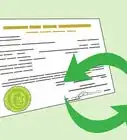This article was co-authored by Clinton M. Sandvick, JD, PhD. Clinton M. Sandvick worked as a civil litigator in California for over 7 years. He received his JD from the University of Wisconsin-Madison in 1998 and his PhD in American History from the University of Oregon in 2013.
This article has been viewed 212,461 times.
Adopting a family member, commonly known as a kinship adoption, can benefit not only the child, but also the extended family. When a parent dies, becomes unable to care for the child, or the child ends up in the foster care system, a kinship adoption can preserve the bonds of family and smooth the transition for the child into a new life. Kinship adoptions can be complicated and usually require legal assistance to complete. However, there are many steps you can take to make the process go smoother.
Steps
Planning for the Adoption
-
1Consider the effect on your family. Many placements with relatives are a result of the parents being unable to care for the child. There may have been neglect, even abuse of the child, and the situation may be very emotionally charged in the family.
- Grandparents may especially be torn between loyalty to their birth child and concern for their grandchild. Aunts and uncles are usually closer in age to the birth parent, but taking in a niece or nephew can change the dynamic in marriages and existing families. If the child is old enough to have a relationship with her birth parents, there may be issues of separation and abandonment. Prospective kinship parents should consider family counseling sessions before committing to an adoption.
- If the child came to your family via a court case, discuss kinship adoption with the child's social worker. Make sure you understand the state's role in the adoption.
-
2Evaluate your options and make sure an adoption is right for your family. A kinship adoption is different than other types because it requires people that you know personally, the natural parents, both consent, die, or be declared unfit. There may be competing interests between maternal and paternal grandparents and other factions of the family. The state child welfare agency is almost always involved. There are several options for placing the child and you should speak with an attorney or social worker to do what is best for the child and your family.
- Custody and legal placement. To keep the child out of the foster care system, the court will look to blood relatives first. If you are fit and have the resources to care for the child, the state will often take legal custody of the child and place her in your home. You handle all the day-to-day activities of a parent under the supervision of the court. This is always a temporary situation, usually lasting less than a year. [1]
- Guardianship. This can be a good option for kinship placements. The court issues an order that gives you legal custody of the child and all legal rights to act as her parent. The difference between a guardianship and an adoption is that the rights of the birth parents are not severed. However, if the birth parents want to be involved in the child's life, they must go to court. In a guardianship, you may be eligible to receive child support payments from the birth parents. [2]
- Adoption completely severs of the birth parents' legal rights to the child. As the kinship adopter, you become the child's parent in all facets of the law. You have the same rights and responsibilities of any other parent. [3]
Advertisement -
3Know your rights in court cases. Generally, under the law, blood relatives have a special status in court cases involving the care and placement of minor children. These cases include when the child is in the custody of the state, when the child survives both of her parents and there is no guardianship in place, or in an adoption proceedings.
- Federal law requires agencies to make reasonable efforts to keep siblings together in one home, offering services as needed to make the placement work. [4]
- If there is a case involving a child who is your blood relative and you can show you have a relationship with the child, you can ask the court for "interested party" status. This means you have a right to receive documents and reports as well as notice of court hearings.
- Ten states have laws requiring agencies to give preference to blood relatives when evaluating adoption placements. [5]
- In most states, if the parent purposely sent the child to live with relatives and consents to the adoption, the laws are set up to streamline the procedure. Typically, if the child has been living with the relative for some time, the home study will be cursory or waived all together. [6]
-
4Research benefits and adoption assistance. Even though protecting your grandchild or niece may be the most important thing in your mind and heart, you also have to cope with the financial realities of raising a child. Most states offer some sort of assistance for adoptive parents. If the child has special needs, most states will offer support, access to services, and in some cases, financial stipends. As the adoptive parent, you will also be eligible to add the child to your employer health insurance or apply for insurance through the state. [7]
-
5Confer with a family law attorney. A kinship adoption is often the most complicated of all adoption proceedings. In a stranger adoption, the parents' rights have been severed and custody transferred to the state before you are even considered. In a stepchild adoption, one of the birth parents is actively involved. However, in a kinship adoption, the issues with the birth parents may be unresolved, there may be resentment in the family, the state child welfare agency may have a custody interest, and the child may be ambivalent about being adopted. As a result, it is not recommended that you attempt to do a kinship adoption on your own as a pro se party.
- If you have the financial resources, you can retain a family law attorney to act on your behalf.
- Write a letter to the court hearing the child welfare case and ask if you qualify for court-appointed counsel.
- Speak with your local Legal Aid office. There is a Legal Aid office for every county in the United States and, if you meet their income guidelines, you may qualify for representation. [8]
- Contact the local bar association. Most bar associations have attorneys who are willing to assist with this type of case for a reduced fee or pro bono.
Filing the Adoption
-
1Institute an adoption proceeding. If the state is not involved, your attorney will file the adoption in the appropriate court on your behalf. A preliminary hearing will be scheduled to give the birth parents an opportunity to file a response to the petition.
- If the birth parents both consent, they will sign notarized forms surrendering their parental rights.
- At this stage, the family of the other parent may request the right to intervene or contest the adoption.
-
2Seek agency cooperation. If a state agency is involved, you will need their cooperation and approval for a kinship adoption. A supportive social worker can be your biggest asset.
- The agency should have the documents needed for the adoption, such as certified birth certificates and parental death certificates. They also have access to records that can help locate absentee parents for service and consent.
- Cooperate fully with requested home visits, interviews, and criminal background checks. Most states have laws in place to streamline these procedures and give preference to blood relatives, but your cooperation is essential. Be open and honest. After the state becomes involved, there is no "private family business."
- Grandparents may be asked to submit to physical examinations to determine if they are healthy enough to be adoptive parents for young children.
-
3Discuss consent to the adoption. If you are looking to adopt a grandchild or the child of your sibling, talk with the family member birth parent about consenting to the adoption. You should also talk to the rest of the immediate family about their feelings. Forcing the court to sever parental rights can cause dissent in the family that is not good for the child.
-
4Work with your attorney. You may need to provide your own birth certificates, marriage and divorce documents, and employment records. Don't keep any secrets from your lawyer. If there is something in your past that may be an issue, such as a former drug problem, health issue, or criminal conviction, be honest about it before it becomes an issue in the adoption.
- If your attorney is court-appointed, Legal Aid, or working pro bono, you will likely be able to get the court filing fees waived. Speak with your attorney about the records you will have to provide.
- If there is a child welfare case, the state will handle the severance of the birth parents' rights. If the case goes to trial, you may be called to testify about anything you witnessed and about how you have been caring for the child. If you receive a subpoena or other notice from the state, contact your attorney immediately.
Finalizing Your Kinship Adoption
-
1Attend all court hearings. Your attorney will give you notice and discuss what he believes may happen at the hearings. The first court date will be after all parties have been served and their time to respond has expired.
- If the birth parents have consented or had their rights severed by the state, they are not required to attend.
- If the family of the other birth parent or other family members want to object to the adoption or intervene, they may appear. Don't be hostile, no matter how angry or disappointed you may be. Direct all communication to your attorney.
- Do not bring the children unless instructed to do so by your attorney. Some judges have rules against children in the courtroom and you cannot leave them unattended in the hallway. If you are working with the social welfare agency, they may have a playroom at their offices where the children can wait while you are in court.
-
2Anticipate a trial. Most kinship adoptions are uncontested. The family understands, agrees, and cooperates to do what is best for the child. However, until the final order is issued, a trial is a possibility. A birth parent can rescind their consent or another family member can interfere. Your best bet is to comport yourself as if the case was going to go to trial.
- Do not discuss the details of the case with the child. If you get questions that can't be answered with generalities, consider a family counseling session. Do not disrespect the birth parents to the child.
- Do not discuss the details of the case with other family except in very general terms. If their input or cooperation is needed, let your attorney handle the communication.
- Do not be hostile toward the family of the other birth parent. Even though rights have been surrendered or severed, they are the child's family as much as you are. The child may have significant affection for their other grandparents and aunts, uncles, and cousins. Discuss the issue with your attorney and social worker how to allow contact with the child, especially around the holidays.
-
3Attend the final court hearing. At this hearing, whether or not there was a trial, the court will review the documents and ask if you want to adopt the child. The state agency will likely attend and give their approval for the final adoption. If the children attend, the judge may talk to them.
- The judge with either acknowledge that the birth parents consented or that there rights have been previously severed. If not, the judge will make a finding of fact that the parents are unfit and enter an order of severance.
- Upon signing of the order, you become the child's legal parent.
-
4Update the child's birth certificate. When you receive the file-stamped copy of the final adoption, you can file for a new birth certificate. Depending on your relationship to the child, for example you are the maternal grandparents, you may change the child's last name to match yours.
-
5Create a safety plan. Kinship adoptions are unique in that one or more of the birth parents may still be in the picture. It is up to you to decide how much, if any, contact you will allow between the birth parents and the child. Most kinship adoptions are successful and happy. However, depending on the family situation, you should be aware of the residual danger of a kinship adoption.
- If the parents' rights were forcibly severed, there may be hostility and danger to the child. Update the family information with the child's school and caregivers. Inform them who can and can't pick the child up from school and who can access school records.
- If the parents' rights were severed because of substance abuse or physical abuse, use your judgment in allowing contact. Protect the child like you would with anyone you felt might be a danger.
- If a birth parent or other family becomes threatening, consider taking out a restraining order to protect you, your child, and your home.
- If a birth parent or other family member leaves with the child or will not return the child after a visit, take the adoption papers and new birth certificate to law enforcement. This will help make them understand the situation and get them to help you retrieve the child.
References
- ↑ https://www.childwelfare.gov/pubPDFs/placement.pdf#page=2&view=Giving Preference to Relatives for Out-of-Home Placements
- ↑ http://www.helpguide.org/articles/grandparenting/grandparents-legal-rights-and-custody-options.htm
- ↑ http://www.childsworld.ca.gov/pg1302.htm
- ↑ https://www.childwelfare.gov/pubPDFs/placement.pdf#page=4&view=Adoption by Relatives
- ↑ https://www.childwelfare.gov/pubPDFs/placement.pdf#page=4&view=Adoption by Relatives
- ↑ https://www.childwelfare.gov/pubPDFs/placement.pdf#page=4&view=Adoption by Relatives
- ↑ https://www.childwelfare.gov/topics/adoption/adopt-assistance/
- ↑ http://www.lsc.gov/find-legal-aid
About This Article
To adopt a family member, you may want to consult a family law attorney, since kinship adoptions can be complicated. If you can't afford an attorney, find out if you can apply for a legal aid program. You should ask the attorney to institute an adoption proceeding with a court. Additionally, speak to the other family members to see if they're willing to consent to the adoption so that the court doesn't have to impose a decision. Next, contact the relevant social worker to get their support for the adoption, which will prove helpful in court. Then, attend all court hearings before signing a document at the last hearing to confirm the adoption. For tips on how to update your adopted child's birth certificate, keep reading!











































































